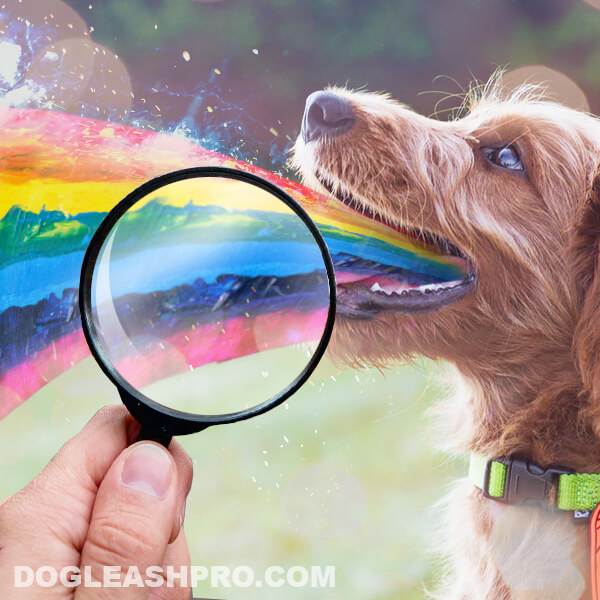
Last week, I came home from a quick run to find dog vomit all over my living room carpet and floor. The dog vomit smell was quite strong, unpleasant and it was brown! Ewww! Like other dogs, my furry pal is not immune to the occasional vomiting and will vomit if something she ate caused an upset stomach.
In fact, I later found out my dog has Coprophagia and must have eaten the unthinkable during our walk earlier that day. This is just one of many different reasons that can cause your dogs to vomit. The good news is that the dog’s vomit comes in different colors and textures, which can tell you the cause of their vomiting.
If your dogs are vomiting, be sure to keep a close eye on them. Many owners with wireless dog fences allow their pups to hang out in the backyard and they may also vomit on the grass.
We will go over the different colors and textures of the dog vomit near the middle of the page so you have a dog vomit color guide to follow. We’ll also consider what may be causing a gastrointestinal upset in your canine friends.
Table of Contents
Did your dog really vomit or was it something else?
Whether you’re a first-time dog owner or have owned dogs for several years, sometimes we can all confuse our dog’s regurgitation or cough for vomiting. Let’s go over how you can tell if your canine friends are actually vomited.
If you’re like me, you also live a busy life working from home or tending to chores around the house so we’re not always there to monitor our K9 friends’ every move. However, when there is a colored spot on the floor and it is wet, we will definitely find it. We just didn’t see them in action.
Perhaps your dog just vomited but how they vomited looked different from what you had imagined or expected.
One time, my dog was actually dry heaving or retching and I thought she was vomiting. That’s because her dry heaving and vomiting both sounded the same to me and the expression on my dog’s face when she was dry heaving looked like she was vomiting, but nothing came out of her mouth. When I consulted with my dog’s vet, she confirmed that my pooch was actually dry heaving.
So to help differentiate between regurgitation, coughing, and vomiting, we will discuss each one so you understand what you are looking at and know how to find the root cause of the problem.
Dog regurgitation vs vomit

If you’re like me, I had a difficult time determining whether my dog actually vomits or if she just regurgitated her water and food.
The difference between vomiting and regurgitating is the following:
Vomiting
Dogs vomit if the food already made its way down to the stomach and is coming back up and out of your dog’s mouth. Dogs may throw up digested food and will experience nausea, dizziness, and abdominal retching. These symptoms may also cause dogs to have diarrhea as well.
Regurgitation
Sometimes dogs will regurgitate to get rid of the food or water in the esophagus. This usually happens right after your dog consumes the water or food. Sometimes a dog may drink the water too fast or eat their food so quickly that some part of the food or water gets stuck in the esophagus.
Dogs can also regurgitate their food or water if they start running, jumping, and playing right after their meal instead of relaxing.
It’s also most likely regurgitation if your dogs immediately throw up their water or food after consuming it without any prolonged gagging or dry heaving.
Dog Vomiting vs coughing
One fall afternoon my dear Chihuahua was shaking so hard while sitting on my lap. All of a sudden, she started to cough really loud and hard. What came out looked like phlegm or yellow mucus and foamy fluid. It flew out of her mouth and onto my sofa. Initially, I thought that was vomit, but it wasn’t.
I can tell my Chihuahua was coughing because she was hacking at first and then there was loud gagging or retching afterward. Once she started retching, small amounts of fluids came flying out as she coughed it out. Sometimes, you can hear your dog swallowing it.
You’ll know your furry friends are coughing and not vomiting if they cough a few times throughout the day. My Chihuahua was coughing every other hour and that is when I knew I had to bring her to the vet.
Signs of nausea in dogs
When I came home to find a pile of dog vomit on my living room carpet and floor, I didn’t know which of my dogs was the culprit since I have two dogs at home, a Labrador and a Chihuahua. If you have more than one dog in your home like I have and you’ve just found a wet-colored pile of vomit on your carpet, floor, couch, or furniture, you’re probably wondering which dog is responsible for it.
Here’s how I was able to find out which of my two pups was responsible for the dog vomit. It starts with finding out which of your furry family members is experiencing or having nausea.
Signs of nausea in dogs include:
- Loss of appetite even though it is one of their favorite foods.
- Lethargy: your dog appears to feel down and tired.
- Drooling usually occurs right after your dog vomits.
- Does not want to go for walks even though your dog has always been excited and happy to go for walks.
These signs and symptoms will help you determine which one of your pups vomited and needs special attention. Once you know which dog it is, be sure to contact your vet right away and find out what you can do to help your pooch feel better.
Causes of vomiting in dogs and puppies
Once you find out which dog vomited and is feeling nauseous, you may wonder if he or she has an upset stomach.
Let’s take a look at the most common reasons that cause vomiting in dogs.
- Consuming food that contains toxic ingredients such as onion or garlic or greasy food.
- Ingesting spoiled or leftover food from the trash can.
- Change in diet or food amount: Dog owners may accidentally overfeed their pooch which can cause them to vomit.
- Ingesting foreign objects like ball toys, socks, or bones.
- Eating toxic things like medications, poisonous plants, or grass that’s been sprayed with pesticides.
- Eating food your dogs are allergic to such as food that contains soy or wheat products.
- Ingesting food that contains dairy products if your pooch is lactose intolerant.
- Pancreatitis.
- Intestinal parasites.
- Bacterial infection.
- Motion sickness from being in a car or moving around too much.
- Health issues such as kidney or liver failure, diabetes, or some form of canine cancer.
- Stomach inflammation.
- Dogs with anaphylaxis or severe, life-threatening allergic reactions.
You may also be interested in Can Dogs Eat Spoiled Meat? The Dangerous Truth!
Dog vomit types
It’s important to note that there are different types of dog vomit and each type tells you something different. A dog’s vomit can be watery or chunky with undigested food.
Dog vomit can be broken down into three main categories:
Chunky Dog Vomit
You’ll know that it is a chunky dog vomit if the vomit has both digested and undigested food content in it. If you feed your pooch dry kibbles, some of those kibbles appear to not have been fully digested yet.
This means that the food your four-legged friend just ate has not had enough time yet to digest. If your pup has an upset stomach, it could be something they just ate that did not sit well with their stomach. There could be something that prevents the food from passing through to the gastrointestinal tract.
Liquid Dog Vomit
If your dog is vomiting liquid, then it means they do not have food in their stomach, which is why they are throwing up liquid. If this is the case with your dog’s vomit, be sure to stay alert because this can be concerning. This shows that your pooch is still feeling nausea even if her stomach does not have any food.
If your pup is throwing up liquid dog vomit, be sure to contact your vet as soon as you can because dogs that vomit liquid could be going through other symptoms of nausea, lethargy or extreme tiredness, heavy drooling, and abdominal pain.
Foreign object Vomit
Many dog owners know that their dogs will eat and chew on anything and everything, including socks, toy parts, candy wrappers, shoelaces, and more that they should not be ingesting!
You’ll find out any foreign objects they have swallowed after they have had a foreign object dog vomit. If you suspect your pooch has swallowed a piece of destroyed toy parts, be sure to bring them to see your vet. This is serious because the foreign object can sit in your dog’s stomach for days or even weeks.
Dog Vomit Color Guide
The dog vomit color can range in colors from yellow vomit to white foam. Each of these types of dog vomit has their meaning and can tell the owner what if any current health problems the dog may be having. Some dog vomit colors can indicate serious health issues and your dog’s life is threatened while other dog vomit colors are nothing to sweat over.
We will find out what different color dog vomit means:
Green Dog Vomit
When it comes to dog green vomit, there are several causes that make the dog vomit green.
Green grass
If you have a backyard with grass, your dog may be chewing and eating some of that grass. For instance, my Chihuahua loves eating certain types of grass during the fall and summer. If the grass doesn’t sit well with your dog’s stomach, he or she may throw up bright green dog vomit. If this is the case, you may be able to see small pieces of grass in the vomit since grass isn’t easily digestible.
Bile or digestive fluid
Bile or digestive fluid is usually produced in the dog’s liver and if your pooch vomits on an empty stomach, the green dog vomit can be bile. Sometimes when your dogs have reflux, they may throw up green vomit.
In cases where your furry friend is throwing up on an empty stomach, we highly recommend that you bring them to the vet right away because it may be due to a serious health issue that you didn’t know about or were aware of.
You may be interested in Why Do Dogs Eat Grass?
Brown Dog Vomit
Like green dog vomit, brown dog vomit can also be due to several reasons.
Dog’s kibble
The dog’s kibble is usually brown in color. If your dog just ate kibble and it is not sitting right in their stomach, your pooch may vomit. You may be able to see the kibble in their vomit. The vomit can be brown because when the kibble is digested, the brown coloring from the kibble gets mixed into the digested food before your dog vomits.
Coprophagia in dogs
If your dog has a tendency to eat poop, this could be another reason why he is throwing up brown dog vomit. You’ll notice your dog is eating poop if his breath smells bad. It’s actually pretty common in our four-legged friends. Luckily, this condition is treatable. We highly recommend that you consult with your vet to find the best treatment for your pooch.
Blood traces in the brown vomit
If your pooch is throwing up brown vomit, there could be traces of blood in it. Blood can be dark and can appear brown in your dog’s vomit. Always use a white paper towel or white rag to clean up the vomit since blood can cause bacterial contamination.
We suggest using a white paper towel or white-colored clean-up tools because then you can clearly see what’s in the vomit which will help your dog’s vet diagnose the problem correctly.
Black Dog Vomit
If your dog’s vomit is black and you’re frightened by it, we totally understand. It’s weird to see black dog vomit so it’s important to know what is causing the vomit to be this dark.
Dirt or soil
If your pooch likes to play, jump, and roll around outside in your backyard, they may be eating dirt or soil.
Digested blood
Black dog vomit can also be due to digested blood that looks like the color of the soil and has a granulated texture. There could be blood in your dog’s gastrointestinal tract. This one can be a serious health problem and should be brought to your vet’s attention.
If there’s granulated texture material in your dog’s black vomit, be sure to speak with your vet right away.
Red Dog Vomit
If you’re like me, you may feel like fainting or passing out when you see blood or red liquid. Some dog owners contact their vet right away when they see red dog vomit because they think it’s blood in there. But there are also other reasons for the red dog vomit.
Dog’s food
Did you recently feed your pooch dog food or human snacks that has red food coloring in them? Some treats like Fruit Snacks are made for human consumption which also contain red food coloring or dye. Most dog food like dry kibbles also contains red food coloring. If these treats or food don’t sit well with your dog’s tummy, your pooch will likely throw up red vomit.
If it’s not due to any food or treats you’ve given your pooch, then it could be a sign that there’s blood in your dog’s vomit which causes the vomit to be red.
Health issues causing red dog vomit
There are a number of reasons that can cause red bloody vomit in dogs including:
- Gastrointestinal tract irritation from gastrointestinal health conditions.
- Stomach irritation.
- Hemorrhagic gastroenteritis or HGE.
If you suspect your pooch has any of these health problems, it’s best to contact your vet as soon as possible. Any blood in your dog’s vomit is what we considered an emergency and your vet should be informed right away.
Yellow Dog Vomit

Bile or digestive fluid
Similar to green dog vomit, yellow dog vomit can also indicate that there is bile in the vomit. If your pooch didn’t eat anything and he is throwing up, then it can be bile from your pup’s liver or other organs and not due to the food they just ate. They may feel nauseous and throw up due to other medical conditions. If you’re not sure, it’s always best to contact your vet.
Acid reflux
Some dogs may throw up yellow vomit because they have acid reflux.
White Dog Vomit
If you see white dog vomit, you may be startled by the white foamy vomit. There are many reasons why your dog may be vomiting white vomit.
Digestive system
If your pooch hasn’t eaten and is on an empty stomach when he threw up white dog vomit, then it could be that the vomit was moving around in the digestive tract before it came out of the dog’s mouth. The white foam from the vomit could be due to its contact with the air.
Contact your dog’s vet immediately if you notice this.
Gray Dog Vomit
If your dog has gray vomit, it can be something serious. When dogs have gastrointestinal upset, one of the symptoms is gray liquid vomit. To break this down, it means:
- Gray vomit may mean there is dilute bile or white foam.
- Liquid vomit means your dog is throwing up on an empty stomach.
This could indicate that your dogs are not eating their standard number of meals each day and even if they do eat, the food doesn’t reach their digestive system. Instead, the food keeps getting thrown up.
Word of advice
Regardless of your dog’s vomit color, it’s important to keep your vet informed when your dog throws up liquid vomit. Your vet will be able to find the source of the problem after careful examination and diagnostics. Once the vet is able to find the root cause of the issue, they will be able to provide your pooch with proper treatment.
As you can see, there can be several different reasons why a dog is vomiting – from not eating the right food to health issues such as liver failure or kidney disease.
When should you contact the vet?
When dogs vomit, the dog owner should alert and observe their pups carefully. There are cases when our canine friends vomit once because of a small upset stomach and then they are back to normal, but there are also other cases that require the vet’s assistance.
There can be health issues that are causing your dog to feel nauseous and vomit as a result.
Dogs that are puking more than once should get the vet involved so the vet can look into the source of the problem. Make sure not to wait too long before getting help from your vet because vomiting more than once can cause dehydration in dogs. Dehydration can be uncomfortable for your canine friends and can also be life-threatening.
Remember the sooner you’re able to contact the vet after your dog vomits, the quicker you’re able to find out the source of the problem and the sooner you’ll be able to treat your pooch. This way, your furry friend is able to get back to feeling well again.
Conclusion
Our dogs are like our kids and just like we will do anything for our kids, we will do anything for our furry pals as well. When our dogs vomit and are not feeling well, it makes a huge difference when we know or understand what their vomit color means so bookmark this Dog Vomit Color Guide page for any future references in the event your pooch has another vomiting spell.
DISCLAIMER: THIS WEBSITE DOES NOT PROVIDE MEDICAL ADVICE
The information, including but not limited to, text, graphics, images and other material contained on this website are for informational purposes only. No material on this site is intended to be a substitute for professional veterinary advice, diagnosis, or treatment. Always seek the advice of your veterinarian or other qualified health care provider with any questions you may have regarding a medical condition.
Resources:
https://www.akc.org/expert-advice/health/should-i-call-my-dogs-vet/

With over five years of specialized experience as an animal writer, my expertise lies in dog nutrition, health, behavior, grooming, and training. I am dedicated to delivering helpful and informative content that caters to the well-being of our furry friends. My primary goal is to empower pet owners with knowledge and ensure our canine companions thrive in health and happiness. In my free time, I love volunteering at local dog rescue centers.







